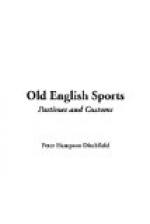[Illustration: PALL-MALL.]
[Illustration: TENNIS.]
There were some other forms of ball-play, such as balloon-ball, stow-ball, &c.; but of these it is hardly needful for me to speak, as they are only varieties of those games which I have already described. The history of football has been narrated in a preceding chapter. You will be able to trace from the descriptions of these old sports the ancestors of our noble game of cricket, and wonder at the extraordinary development of so scientific a game from such rude and simple beginnings.
The floors of the houses and churches of old England consisted simply of the hard, dry earth, which the people covered with rushes; and once a year there was a great ceremony called “Rush-bearing,” when the inhabitants of each village or town went in procession to the church to strew the floor with newly-cut rushes. The company went to a neighbouring marsh and cut the rushes, binding them in long bundles, and decorating them with ribands and flowers. Then a procession was formed, every one bearing a bundle of rushes; and with music, drums, and ringing of bells they marched to the church, and strewed the floor with their honoured burdens. Long after the rushes ceased to be used in churches the ceremony was continued, and I have witnessed a rush-bearing procession such as I have described. There was a rush-cart with a large pile of decorated rush-sheaves, and some characters from the May-day games were introduced. A queen sat under a canopy of rushes, a few morris-dancers performed their antics, and a jester amused the spectators with his quaint sayings. A village feast, followed by dancing round a May-pole, generally formed the conclusion of the day’s festivities. In 1884 this pleasant custom was revived at Grasmere in the Lake district, when the children of the village carried out a “rush-bearing” after the manner of their forefathers, and the village green again resounded with songs of joy.
I fear that our ancestors were not always very cleanly people; they seldom washed their floors, and therefore they were obliged to adopt some device to hide their uncleanliness. The old rushes were not taken away before the new ones were brought in; hence the lowest layer became filthy, and one writer attributes the frequent pestilences which often broke out to the dirtiness of their floors and the masses of filthy rushes lying upon them. Perhaps some of the wise folks in Lancashire discovered this, for we find the following entry in the account books of Kirkham Church, 1631—“Paid for carrying the rushes out of the Church in the sickness time, 5._s_. 0_d_.” Straw was used in winter: it would seem very strange to us to have our floors covered with straw, like a stable!
In this matter of cleanliness we have certainly improved upon the habits of our forefathers: dirty cottages are the exception, and not the rule, as they were in the days of “good Queen Bess”; and the absence of those terrible plagues which used to devastate our land in former times is due in a great measure to the improved cleanliness and more careful regard for sanitation by the people of England.




